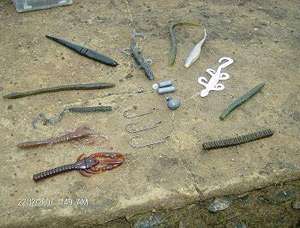
The bundled figure opens the bail and, with a practiced flip of the wrist, sends the awkward-looking rig sailing toward the cold water.
"The key to Carolina rig fishing in winter," he says, watching the line play out, "is to slow it down." As the weight strikes the bottom, the lizard flutters in pursuit and the contest is engaged.
A resident of Salem, Va., and an angler by passion, Barry Kelley knows the value of a Carolina rig in any season.
"I'm real happy to be here, sure. But, I'd much rather be wearing shorts and a tank shirt", Barry says in response to a chilling gust of wind. We're standing on the rocky, drought-stricken bank of a southwest Virginia reservoir above a series of ledges leading to a roadbed. It's a perfect cold water scenario.
Barry knows that Carolina rigging in colder water is an exercise is patience, presentation and adaptability. "For me," he explains, "it's best to try active baits when you first reach the water. You get an idea of the activity level of the fish and what depth they're working at." He commonly goes to the C-rig when the fish are slow, deep and fickle like they are on this cold morning, just three days before Christmas.
Why the Carolina Rig? According to Barry, the technique allows the angler to put the bait where it needs to be and to look and act like it needs to draw the strike.
He carries a 6'6" medium-heavy rod and a spinning reel spooled with 14 lb. green mono.
"What about fluorocarbon?" I ask.
"It'll work fine," he replies, "But, I just bought a bunch of green mono, and I need to use it up."
Sometimes practical questions get very practical answers.
I watch as Barry re-ties after a nasty hang up. His weight choice is a 3/8-ounce cylindrical sinker.
"I find that I don't seem to get hung up as much with finesse weights like I do with a pointier nose," he offered. Barry then threads on a smooth, clear, plastic bead and adds, "I used to use the standard red glass bead. But, I found the fish were hitting the bead. I didn't want the attention of the fish focused on the bead." He also explained that plastic beads wouldn't break and cut the line as much.
Barry ties a black crane swivel to the 14 lb. mono and attaches his leader. It's always important to use line that is a couple of pounds lighter than the main line. Per Barry, it's better to lose the hook instead of expensive weights and swivels.
He has no preference regarding hooks. They have to be sharp and not so big that they impede the action of the bait. Today, Barry ties on a 3/0 offset model, but he carries 1/0 and 2/0 hooks for more finesse presentations.
In cold water, lure choice is vital. As water temperatures drop, bass have less forage to choose from and tend to focus on the remaining baitfish. By mid-fall, Barry relies on smoke colored lures, especially 5-inch lizards.
"It looks just like a baitfish", he says. His tackle bag contains several types and colors of plastics "just in case."
The terminal tutorial complete, I watch as Barry casts again and starts his retrieve. He slowly brings the rod from a 45-degree to a 90-degree angle. I count six seconds from 45 to vertical. From experience, he believes that this retrieve imparts a subtle, gliding action to the lure once the weight stops. If the fish want something faster, he'll use a sideways retrieve and sweep the rod across parallel to the water.
The Carolina rig can be a productive technique in any season — even the dead of winter. By matching the forage, slowing down the retrieve and using the correct terminal tackle, we did pretty well for a windy, winter day on 44-degree water, tallying eight keepers, including two smallies over 20 inches!




